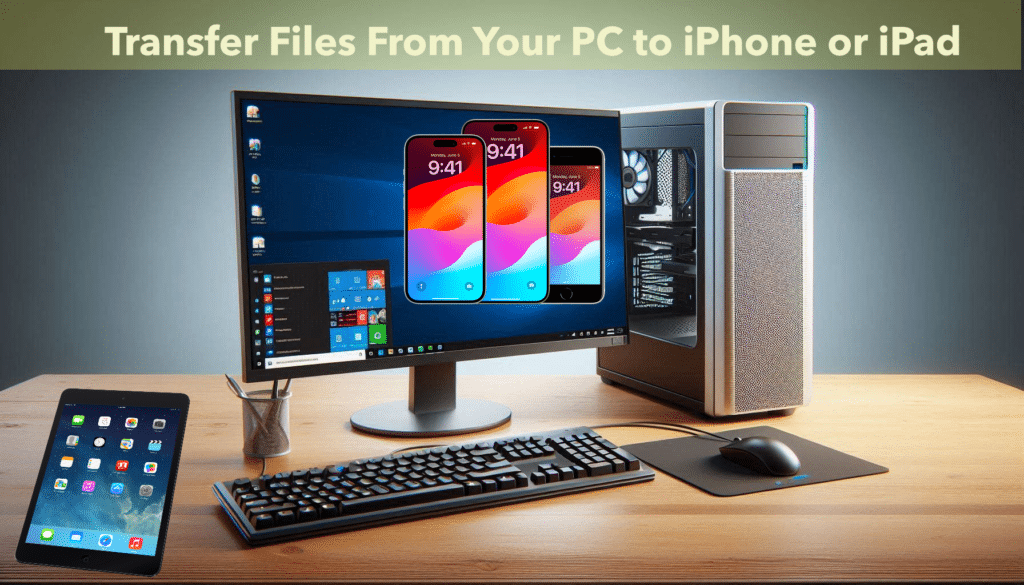Looking for ways to move files between your Windows PC and iPhone or iPad? You’ve got options! This guide explores several methods to get your videos, photos, documents, and more onto your Apple device.
Highlights
- Top Methods to Transfer Files from PC to iPhone/iPad
- Additional Considerations
- Final Thoughts
- Frequently Asked Questions
- Ques 1: Can I transfer files from my PC to my iPhone/iPad without using the internet?
- Ques 2: What if my file is too large to email to myself?
- Ques 3: How do I ensure my files are secure during transfer?
- Ques 4: Is there a way to transfer files that doesn’t involve installing new software?
- Ques 5: What should I do if my iCloud storage is full?
Top Methods to Transfer Files from PC to iPhone/iPad
- iCloud: Apple’s cloud storage service, iCloud, offers a convenient way to transfer files wirelessly. Simply download and install iCloud for Windows from the Microsoft Store. Sign in with your Apple ID, choose to sync iCloud Drive with your File Explorer, and upload your desired files. Once uploaded, access them on your iPhone or iPad through the Files app.
- File Sharing Apps: Many communication apps like Slack, Dropbox, and Telegram allow you to upload files and download them on your mobile device. This can be a handy option for smaller files you need to access quickly.
- Email Attachments: You can always email files to yourself! Attach the file to a new email, send it, and then open the email on your iPhone or iPad to download the attachment.
- Physical Drive (USB Flash Drive): A trusty USB flash drive can be a great option for transferring larger files. Use a USB Type-A to Lightning adapter for older iPhones/iPads or a USB-C adapter for newer models. Simply copy your files to the USB drive on your PC, then plug it into your Apple device using the appropriate adapter. You’ll then be able to access the files through the Files app.
Additional Considerations
- Free vs. Paid Storage: While iCloud offers free storage, it’s limited. Upgrading to a paid plan provides more space for your files.
- File Size Limitations: Some methods, like email attachments, might have file size restrictions.
- Security: Ensure proper encryption for sensitive files, especially when using cloud storage or email attachments.
Final Thoughts
Transferring files from your PC to your iPhone or iPad is easier than ever with a variety of methods to choose from. Whether you prefer the convenience of cloud storage, the speed of file-sharing apps, or the simplicity of physical drives, there’s a solution to fit your needs. By understanding the pros and cons of each method, you can select the best approach for your specific files and devices.
Quick Look: Step By Step Transfer Photos From Iphone To Windows PC
Frequently Asked Questions
Ques 1: Can I transfer files from my PC to my iPhone/iPad without using the internet?
Ans: Yes, you can transfer files without using the internet. Using a USB flash drive with a USB Type-A to Lightning adapter for older iPhones/iPads or a USB-C adapter for newer models allows you to transfer files directly. Copy the files to the USB drive on your PC, then connect it to your iPhone or iPad to access the files through the Files app.
Ques 2: What if my file is too large to email to myself?
Ans: For large files that exceed email attachment limits, consider using iCloud or file-sharing apps like Dropbox or Telegram. These methods do not have strict size limitations and can handle larger files more efficiently.
Ques 3: How do I ensure my files are secure during transfer?
Ans: To ensure the security of your files, especially sensitive ones, use encryption methods. When using cloud storage services like iCloud or email attachments, enable encryption options if available. For added security, use file-sharing apps that offer encryption.
Ques 4: Is there a way to transfer files that doesn’t involve installing new software?
Ans: Yes, emailing files to yourself is a method that doesn’t require installing new software. Simply attach the file to an email and send it to your own email address. Then, open the email on your iPhone or iPad and download the attachment.
Ques 5: What should I do if my iCloud storage is full?
Ans: If your iCloud storage is full, you can either upgrade to a paid iCloud storage plan for more space or use alternative methods like file-sharing apps (Dropbox, Slack) or physical drives (USB flash drives). These methods do not rely on iCloud storage and provide additional options for transferring files.

